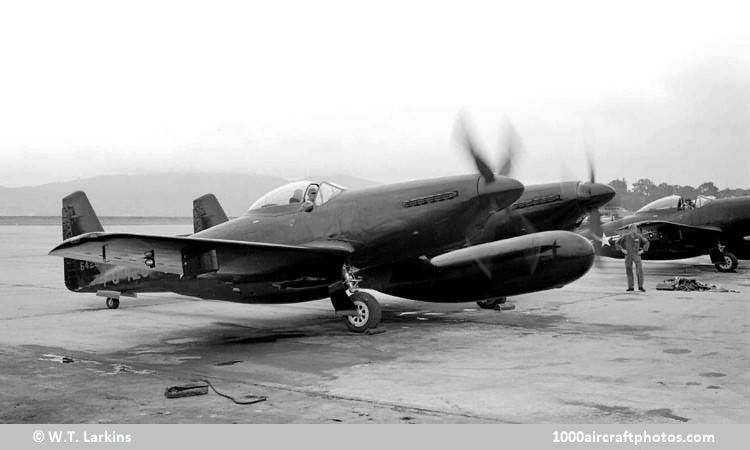The first of two NA-120 prototypes designated XP-82 flew on April 15, 1945, some sixteen months after the start of work on the project. These aircraft had two Packard V-1650-23/25 Merlin engines with opposite rotation to eliminate engine torque while a third prototype, the XP-82A, had Allison V-1710-119 engines both rotating in the same direction. Before the first flight, the USAAF ordered 500 NA-123 P-82Bs with Merlin engines but only twenty of these were built before the wholesale cancellation of production contracts after VJ-Day.
During 1946, the tenth and eleventh P-82Bs were converted to night fighters, carrying radar in a large pod beneath the center section and the starboard cockpit was equipped for a radar operator instead of pilot. These two aircraft had two different types of radar, SCR 720 in the NA-123 P-82C and APS-4 in the NA-123 P-82D.
To replace the Northrop P-61 Black Widow, the USAF ordered 100 NA-149 P-82Fs with SCR 720 and fifty NA-150 P-82Gs with APS-4 in 1946, together with 100 NA-144 P-82Es without radar for service in the escort fighter role. All were fitted with 1,600 hp Allison V-1710-143/145 engines, with opposite rotation. The Twin Mustang was the last piston-engined fighter ordered in quantity by the USAF. North American completed nine P-82Fs and five P-82Gs as P-82Hs for service in Alaska, with special features to permit cold-weather operations, this action reducing the P-82F contract to 91 and the P-82G deliveries to 45. The designation of all B to H models from was changed to F-82 in June 1948.
Air Defense Command was the primary operator of Twin Mustangs, and had 225 F-82F and G models on strength at the end of 1948, as replacements for the P-61. The F-82E served as a long-range escort with one SAC wing. By 1950, the F-82 was deployed overseas as part of the Fifth Air Force in Japan. The F-82s of the 347th Fighter (All-Weather) Group of the 8th F-B Wing, including the 4th, 68th and 339th (All-Weather) Squadrons at Itazuke, thus were among the first USAF aircraft to operate over Korea, and Lt. William G. Hudson, flying F-82G (46-383) of the 68th squadron, is officially credited with the first air-to-air victory of the Korean War, and he was also the first pilot serving with the USAF (rather than the USAAF) who scored a 'kill'."
|
Production
Total: |
|
|
Span: 51 ft 3 in (15.62 m)
Length: 42 ft 5 in (12.93 m)
Height: 13 ft 10 in (4.22 m)
Wing area: 408 sq.ft (13.9 sq.m)
Weight empty: 15,997 lb (7,256 kg)
Loaded weight: 25,591 lb (11,608 kg)
Max speed: 461 mph (742 kmh) at 21,000 ft (6,401 m)
Cruise speed: 286 mph (460 kmh)
Climb: 3,770 ft (1,149 m)/min
Service ceiling: 38,900 ft (11,857 m)
Range: 2,240 mls (3,605 km)
Guns: Six 0.50 in (12.7 mm) in wing center section
Bombs: Four 1,000 lb (454 kg) external
